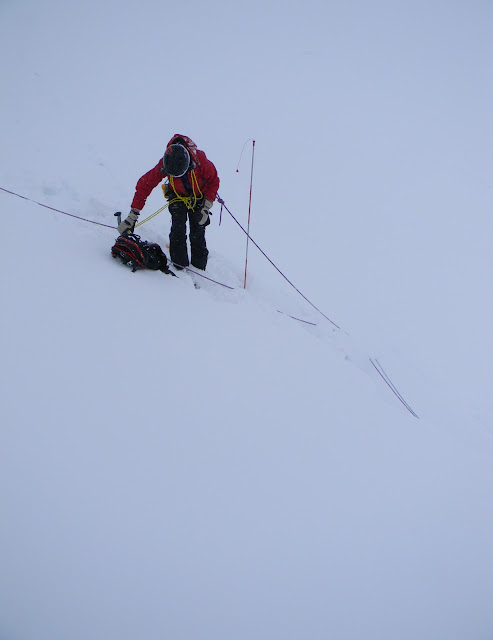Cameras Keep Secrets
I've been completely beside myself with envy whenever I notice a new post on Dave's blog. There is a really great chance that he has been somewhere excruciatingly beautiful, learning some crazy new survival skill, or just enjoying the opportunity to appreciate skiing under the full moon. Despite living in Canmore, a city where people are always ready to leap into an extreme adventure, it seems as though there is a shortage of people who will just wander into the mountains (and I use the term wander very loosely) if there isn't some obvious and lofty goal to pursue. That leaves a niche for someone like me and a couple of others who simply enjoy the journey -- that struggle of getting from one spot to another -- to go along for the ride.
But, not this time :(

Dave spent the spring equinox learning advanced glacier survival skills(his blog, again). With the crevasse of learning between us, I'm sure he would have never consider taking me on this kind of journey, even if I were foolish enough to ask. Anyway, it's not the trip that I long for, in this case... it's the pictures. He was shooting in some extreme conditions and it made things very tricky. I increasingly find myself looking at pictures and wondering how I would have changed the way things were shot, or how I would treat them in post processing to get the result I was looking for. I get the chance often enough with my own photography, but I always have my own experience to fall back on -- as a touch stone to reality. Since I lacked that in this case, I asked myself "what I would like to get out of his photos?"
I guess I want something that helps me tell a story. The photo as it is above gives a great glimpse of just how dangerous the conditions on any glacier can be and in this case, there were blizzard conditions on top of that. For all that, I am aware that the human eye is much better at detecting shadow and light than any single image is capable of displaying. On the other hand, the camera often captures a lot more than we give it credit for. Even a compact Canon Coolpix like Dave was shooting with.
So, what did he see. Dave gets to move around a scene. His eyes constantly adjust to any vista and allow him to see a whole range that is lost from the picture.In the photo above, his camera captured some of the crucial detail that I sought out: the crevasse into which their instructor has deliberately lowered himself -- entirely invisible in the untouched photo. My edit is quite rough, due to my amateur hand and limited time, but I was pretty happy with the result.
The exposure of the original is actually pretty good, if you are looking at the person as your subject. In this case, I was more interested in the gash in the snow. I dropped the exposure on the entire photo to bring back those faint shadows and then raised the highlights and whites. I increased the contrast and then dropped saturation to keep the whole thing from turning blue. By this point the person had become a black blob, so I zoomed in and counterbalanced all my edits to try and bring her back into view. Finally, I cropped the photo to eliminate a bunch of white that my tinkering had destroyed anyway. My edits introduced a lot of problems into the picture, but ultimately showed me what I wanted to see -- the story of the terrain.
I want to take a second to point out that there were many pictures in his post that I think told their story perfectly well without any editing. It's a "squeaky wheel" type of situation here. I'm giving all the attention to the photos that didn't work (for me). And, if you are simply shooting to archive, you probably don't want to waste your time mucking around with hue and contrast. After all, you could be out skiing or hiking.
I used very similar technique on the above photo. The only difference being that I cropped this one to try and emphasize the height difference (which Dave mentioned) and give it more of an "over the shoulder" feeling.
I edited everything in Adobe Lightroom 4, which will set you back $150 after their recent price drop. You can do most of what I did with any number of free programs and for the more advanced, I supposed you could use GIMP if you are so inclined. LR makes it all pretty easy, once you know what you are doing.
Mission accomplished. Having a DSLR to shoot with and doing it in RAW format would have allowed for a more subtle interpretation. There is simply way more information to work with. But, as Dave is fond of pointing out (and I have discovered first hand), it is an incredible sacrifice even to take a small camera into these kinds of conditions. I'd like to think that I would make that choice, but I'm sure I'd bitch (and brag) about it for weeks afterwards ;)
Thanks to Dave for giving me permission to use his pictures here.






Comments